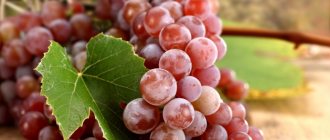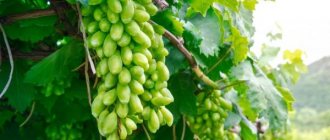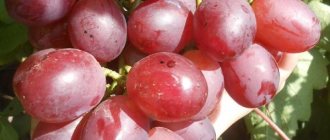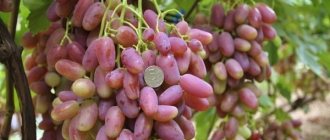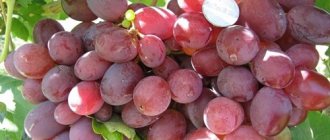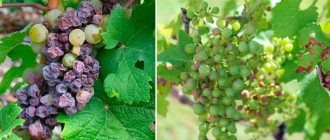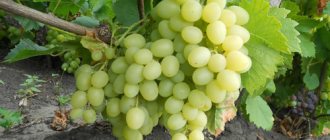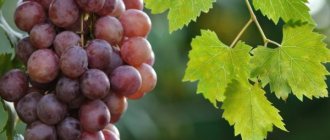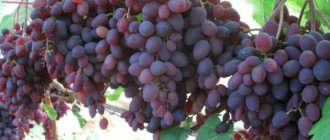Fruits and berries » Grapes
0
960
Article rating
Kira Stoletova
The best option for preparing raisins is Nakhodka grapes. It is characterized by good shelf life and rapid drying. If you pay attention to the particular care requirements of this variety, it is possible to grow high-quality products.
Description grapes Nakhodka
Pomology
Amateur breeder V.N. Krainov, creating the Kishmish Nakhodka variety, instilled in him the best qualities of his parents (Talisman x Kishmish Radiant). High yield - 6-7 kg per bush. The early ripening period for Nakhodka grapes is the end of August. A bunch of grapes – 500-700 g, cylindrical-conical. Berries – 5-7 g, equal in size.
Attention! Changing color - from light pink to red, the absence of seeds or the presence of rudiments - evidence of unfavorable factors for the growth of Nakhodka grapes.
The grape pulp is sweet, muscat-colored. Increased acidity of berries is a lack of sun and microelements.
Increased resistance of Nakhodka grape variety to diseases. Frost resistance – minus 23°С.
General characteristics of the plant
The culture belongs to the early varieties. Full ripening of the fruit occurs within 3 months after flowering. The plant begins to bear fruit 3 years after planting.
Features of the bush
The bush is characterized by active growth. It grows up to 3 m in height. The main trunk and shoots are powerful, which allows them to quickly acquire a tree-like structure. The flowers are white, predominantly of the female type. The leaves are wide, five-lobed, dark green. The surface of the leaf is smooth and dense.
Fetal parameters
Large berries reach a weight of 10 g. The peel is so dense that the fruits do not crack when dropped or overripe. The shape of the berries is oval. The color is soft pink. The clusters are cone-shaped, each weighing up to 1.5 kg.
According to the description, Nakhodka raisin grapes produce a good harvest. Gardeners collect up to 7 kg of high-quality products from each bush.
Read also: Popular raspberry varieties with photos and video descriptions, varieties for the Moscow region, Siberia
The pulp is dense but juicy. The fruit tastes sweet, without acid or bitterness. There are no seeds, so children are allowed to eat them. Shelf life - up to 3 months.
Landing
The timing of planting Nakhodka grapes depends on the region: South of the country - spring-autumn; Central Russia, North - second half, end of May.
The Kishmish Nakhodka grape variety will be sweet if it gets a place to grow near a southern wall or fence. The quality of the fruit of a variety is influenced by the soil. The Nakhodka variety bears fruit well on light, fertile sandstones.
Additional processing is required: sand - adding humus and compost at the rate of 2 buckets per 1 sq. m. m; heavy clay - sand 1 bucket, compost 3 buckets per 1 sq. m.
When groundwater is close, grapes need drainage.
The roots of Kishmish grape varieties develop well in deeply loosened soil. To do this, dig a planting hole - 100-120 cm deep, with square sides - 100 cm. If you plan to plant several bushes, then the distance between: plants - 150-200 cm, rows - 200-250 cm.
For better water permeability, the bottom is covered with broken red bricks, chopped dry branches, plant debris - a layer of 20-25 cm. The top fertile layer mixed with humus - 2-3 buckets, the hole is filled to the middle. The remaining soil mixture will be needed when planting the seedling.
Important! The hole for spring planting is prepared in the fall, for autumn planting - the end of July.
Grape trellises for the Kishmish Nakhodka grape variety must also be prepared in advance. The support pillars are 250 cm high, buried 65-70 cm, the distance between them is 250 cm. Galvanized wire with a diameter of 3 mm is fixed in 4 rows. The first one is 40 cm from the ground, the subsequent ones are 40-50 cm apart.
For a small vineyard - 2-3 bushes, instead of wire, you can use half-bars 50x50 mm.
Shelter from frost - a simple ditch or a specially built box, for the Nakhodka variety, planted in central Russia, should be prepared simultaneously with the supports.
When the soil temperature is 10-12°C, planting is carried out. The best planting material for Kishmish varieties are considered to be 1-2 year old seedlings with a closed root system, purchased from trusted suppliers.
The cutting is removed from the container without disturbing the coma. Installed in a hole, filled with the remaining mixture, watered with 1 bucket of water.
The open root system of cuttings of the Kishmish variety requires pruning: intact roots - up to 15 cm, diseased roots are cut out completely. 3-4 buds are left on the shoot.
A mound is made in the planting hole. A seedling is placed on the top, spreading the roots along the slopes.
Attention! It is necessary to ensure that the tips of the roots do not bend.
Carefully pour water - 0.5 buckets, cover with the remaining soil mixture. The grafting site for cuttings of the Kishmish variety should be above ground level. Press the seedling tightly, water – 0.5 buckets, mulch the soil.
Forum statistics
207036 Messages in 1634 Topics from 5593 Users. Last user: Amaya Last message: “Let's talk about the weather in Vash...” ( Today at 07:52:22 ) Latest messages on the forum.
Now on the forum
29 Guests, 10 Users
Users in the last 15 minutes: Polina77, Mikhail Alekseevich, 64nikolay64, Yura, Svetla777, Tikhii, Marshal, Nikolay S., therapist, Liza [Blocked] [Section Moderator] [Forum Moderator]
Maximum online today: 77 . All-time maximum online: 2758 (28 July 2021, 17:22:51)
Users who visited the forum in the last 24 hours
Total: 294
(Visible: 293, Hidden: 1) 1963, Polina77, Mikhail Alekseevich, 64nikolay64, Yura, Svetla777, Quiet, Marshal, Nikolay S., therapist, Liza, Capricorn, lomakin1969, Alexander Vl., Elvira2017, Andrey76, Slavka, Mikhail77, ElenkaF, Tatyana B, Alex65, Cherkessk, Eugene, zsb, leonidych, vladimirM, yotmast, mers, Serg1707, SNovichek, hanter64, znakomij, Alexander K, Vardan, Sergey Fer, Anatoly Sivkov, Alexey V, Ilya 77, Andrey Gladilin, Tatyana A., Belgorodets, in Astrakhan, Oksana Kopp, sem_en, Vladimir 153, skier, Igor Viktorovich, slavalimon, Primorets, OlgaOs, SANYCH, 31rus, mystic69, DorontsovPeter, Andrey Tsvetkov, Buba, igor222, Elena Z, vlad51, Kenig, Nikolay Rex, Sergey 1965, Vladimir Buturlakin, DSW, psv1960, Dmitry 77, Vasily V., Vyacheslav03, Natalia Nikolaevna, Sergey Tashchiyan, Igor Sergeevich, alexsandr, kvg, Pioneer, Ekaterina Polyanina, nicson7, Elena Aleshchenko, Alexander-ask-34, Verona, Igor F., Taker, Henry, Yuri72, L.A.P., Yuri Gaivoronsky, Sergeevich, Sergei Chistokletov, Svetlana Streletskaya, Galinka, Alexey Deminov, Igor Naumov, Vyacheslav136, Gloomy, Katrin, AndSanych, Mikhno Alexander, Ded31 , Filippov Oleg, Vladimir ++, Lydia58, ALEXANDER BRYANSKY, Vladimir-kanevskaya, DIL, Amber7394, Marina Protasova, TITOVA LYUBOV, Linx, alexander66, Natalya M, Mikhail Fesenko, Amaya, Alexander71, Boris 1952, tsv, Maximilian, 25nata35, nadia, GALINA ANOKHINA, Igor_K, Alexander Kolesnikov, Ivan Levin, Pitko, weather forecaster, eSAa, cecet71, atseton, Alexander Smirnov, Vladimir Kostochkin, Vladimir Berdnikov, Gocha, pioneer-2, LeXa_KoT, Sergey 61, Sergey Yuryev, Erem, alexss, Evgeniy52, Skif, Vladimir Kovba, dayton, Yuri Semyonov, N.A. Sokolov, Pavlentiy, Sa-shura, Volgogradka, Dmitry Anatolyevich, Grandfather Igor, Andrey Lis, Bublichenko Alexander M, Marina Krymskaya, stenlly2010, irahelm, Vyacheslav Vladimirovich, Vladimir Shilov, Aprel, Dmitry Badaev, gheo55, y_fed, rambo, Yagodka, Valentina Ivanovna, Kryn, oleg9f, DED2, Svetlana Korotina, Oleg Ivanovich Zavezen, Eduard., santra, L2k2m7n, Alexander48, Viknik, Andrey 31, m2d, Valery Rastorguev, Soshnin Yura, Gardener - amateur, Galina, Vasily1111, gardener, marlin64, Salex, sergei, Sergey Ko, Ramiz, Victor_, kosmos, potap05, Yuri 36, VitalySD, Inna161, Vova Kapran, Vladimir Shcherbinin, Valerie, niy1, cfibr, Andrey68 , kulol3, thanatos, Serzh1978, Realist, Artur53, max2008-01, LOZA, AlexanderD, Grandfather Young, Natasha, Zayac, ketch, Rita, alx-74, Iv Iv, Alexander150, Igor K, Vasily Viktorovich, VeraNiK, kdm57, Veniaminovich , Boris Sokolyansky, 77volt, , vikbublik, neposny, Evgen, Victoria Aleksandrovna, Serezha 64, Wintel, Airbone, teri, Sergey Lomonosov, Khramov, serginio, Leonty Yarygin, Irina O., Ser, Nadezhda Grig, Lyubov S., netolya, Saisan, Alexey Agryzkov, Vadi, Zinaida, Vadim, Alexander Taganrog, Sergey Sukhonos, Snezhinets, evgen_26, nau_63, Masha_sadovod, Gennady163, krasnovlad1, Alexander Zinoviev, Vasily 53, Roman Fedorovich, TIS, Alexey Sergeevich, arnyusha, Zheka, Nurtas, kradievska , nick041, Valentina Medvedeva, Sergey43, Andrey S., Nikolay Lipunov, Mst, Vertuoz2, Vladimir VS, NatalyaMed, freesia, Kinna, Mikhail Michurinsk, alekcsan1, VALERY TAMB, Sasha57, MikhAf, Y_Azer, Andrey Beribesov, hunter1955, nut lover, Keys, Ivan Shmelev, Pestle, anton_slash, Nadymchanka, Sergey 31, Volgar, Pavel 64, Tatyana Volzh, Elektronik_t, Alexander 61, spotlight, Alexander Gai, Cheprak
Trimming
Kishmish grape varieties lend themselves well to bush formation, which can be:
- Fan;
- Cordon;
- Gazebo;
- Sleeveless.
A fan formation is considered convenient for work. A correctly formed Kishmish Nakhodka grape bush has 4-6 sleeves of different lengths, fanning out from the base.
Fan formation begins from the first year of a seedling of the Nakhodka grape variety, on which 2-3 shoots are left. In the second year, the shoots are cut off before the buds open, leaving 2-3 eyes. The strongest ones - future sleeves - are tied to a trellis, the rest are removed.
In the third year, pruning is carried out based on the presence of shoots. When there are 4-6 shoots, pruning is carried out to a length of at least 50 cm. When 2 shoots are formed - to a length that can accommodate 3-4 eyes. If the bush has 3 shoots, then 1 is formed as a replacement: 2 are cut to the length of the sleeve, 2-3 eyes are left on the replacement. The shoots are tied up obliquely - like a fan.
Numerous summer shoots of the Nakhodka variety are broken off, keeping the upper branches on the sleeves. Those left - as they grow, are tied obliquely to the trellis.
From the shoots at the end of the sleeves, fruit links are formed in the fourth year. In each, the top shoot is removed. Of the remaining ones: the bottom one is cut off by 2-3 eyes, 5-8 eyes are left on the other.
A replacement for fruit-bearing vines of the Nakhodka variety is prepared from annual shoots with 2-3 eyes, left at the base of the bush. Since wounds do not heal, pruning should be done carefully, at a right angle.
The remaining Nakhodka grape shoots should be well-ripened, of medium thickness, with short internodes, intact, and without signs of disease.
Nakhodka grape bushes covered for the winter are pruned twice. Autumn – preliminary, with the removal of fruit-bearing, immature, diseased shoots. Spring – final, forming the bush.
Grape variety Nakhodka (Kishmish Nakhodka)
The hybrid form of Nakhodka table grapes is one of the many high-quality varieties of “sunny berries” obtained by one of the luminaries of domestic folk selection V.N.
Krainov. Viktor Nikolaevich’s contribution to the expansion of ampelographic diversity at the moment cannot be overestimated. There is hardly a winegrower in our country who does not know about at least one brainchild of Krainov, and during his productive life, the researcher bred several dozen of them. Many of these new products, despite their amateur origin, managed to pass the state test, and, having received variety status, were registered in the Register of Breeding Achievements of the Russian Federation. However, even those hybrids that have not gained official recognition often gained significant success among a large number of winegrowers cultivating grapes in their homesteads, gardens and summer cottages. Nakhodka also belongs to one of them, the name of which is most often used with the prefix “kishmish”. Such an epithet is not at all accidental - the berries of our hero really contain only rudiments of seeds, belonging to the IV class of seedlessness.
It occurred as a result of crossing two very famous varieties - the domestic Talisman, born in the bowels of the Novocherkassk Research Institute of Viticulture and Winemaking named after. ME AND. Potapenko, and Moldavian Kishmish Luchisty from the NPO Vierul. It must be said that this was the author’s favorite combination, from which almost half of his masterpieces originated. Our hero inherited many positive qualities from this parental couple, ranging from large fruit, good taste of berries and attractive appearance, ending with the comparative unpretentiousness of the bushes and their increased resistance to fungal diseases. Of its serious disadvantages, one can note only the functionally female type of flower, which requires the owner to take the necessary measures to ensure sufficient pollination of the plants.
Despite this flaw, the Nakhodka raisin grape has gained a wide circle of fans, and the quality characteristics of the variety are eloquently evidenced by the fact that amateur breeders are already beginning to use it as a mother form for breeding new generation hybrids.
Agrobiological properties
The growth vigor of the bushes is average or above average. The leaves are large, round, consisting of three or five lobes, between which there is significant dissection. The profile of the leaf blade is flat or slightly funnel-shaped due to the lobes raised upward. Its surface is smooth, dark green with light veins that acquire a reddish tint at the base. The upper lateral notches are quite deep, mostly open, lyre-shaped or have parallel sides, with a rounded bottom. The lower cuts are much smaller, they are also open, often V-shaped, but there are also barely outlined ones. The petiole recess can be vaulted or lyre-shaped with a pointed bottom. The petioles are long with bright, clearly visible anthocyanin pigmentation. The denticles along the edges of the leaf are quite aligned, moderately large, triangular and saw-tooth with smooth edges and sharp apices. The flower is functionally female, which is why normal pollination is only possible if bisexual varieties that bloom at the same time are planted nearby. To guarantee, you can also carry out manual pollination, otherwise there is a high chance of getting excessively loosened clusters as a result of the massive shedding of unfertilized flowers. Severe peas are not observed, however, under unfavorable weather conditions during the flowering period, the berries grow in different sizes, which somewhat spoils the external attractiveness of the clusters. The current year's growth matures on time and to a considerable length. The matured vine takes on a reddish-brown color.
The clusters grow very large in size, their weight, depending on the completeness of pollination of the inflorescences, can vary widely - from 700 to 1500 grams. Their shape is conical or branched, the structure is loose or moderately dense. The comb is long, herbaceous, light green in color with pink areas. The standard-sized berries are massive, oval-ovoid or nipple-shaped, 25 - 27 mm long and 21 - 23 mm in diameter. Average weight 7 - 8 grams. Due to the free arrangement on long stems, the grapes do not wrinkle or deform against each other. On the outside, they are painted in an attractive golden-pink color, and the surface is covered with a light layer of protective prune. The fruit pulp is quite dense, pleasant to the taste, harmonious, but without bright shades in the aroma and aftertaste. The juice squeezed from the berries is colorless, its sugar content reaches very high values - 19 - 22 g/100 cm 3, titratable acidity varies from 4 to 7 g/dm 3. The grape skin is medium in thickness and strength; there are no problems with chewing and eating it. There are no full-fledged seeds in the fruits; instead, there are rudiments, the size of which varies from season to season. Due to this, as well as due to other positive characteristics, the tasting properties of Nakhodka sultanas are rated as high.
Harvested grapes are mainly used for fresh consumption. Due to its high marketability and visual appeal, it is in good demand among buyers, and therefore winegrowers who cultivate the variety for sale invariably classify it as a “market” variety. An additional and important advantage for them is the early ripening period of the crop, which allows them to start selling it during a period of limited supply and high prices, which ensures good profitability of cultivation. In addition, Nakhodka bunches are distinguished by good transportability, which makes it possible to move them over long distances without the risk of the berries falling off the ridge or receiving other damage.
Individual farms that grow “sunny berries” for their own needs practice processing surplus crops into juices, compotes, jams and marinades. Our hero shows himself on the good side in this regard too, imparting excellent taste and a rich set of vitamins and microelements to home-canned food. In winter, during a period of shortage of these biologically active substances in the human body, summer preparations will come in handy.
The duration of the growing season for Nakhodka grapes is quite short. From the time the eyes open on the shoots in the spring until the bunches are ready for harvesting, about 110 - 115 days pass, and therefore this variety is classified as early ripening. This is confirmed by the modest amount of active temperatures required for plants to reach harvest ripeness - 2300 - 2400 °C. Such indicators indicate the ability of our sultanas to grow not only in traditional wine-growing regions, but also much further north than them, which, by the way, is what many amateur winegrowers use. Here it is worth paying attention to the winter hardiness of the above-ground parts of the bushes. Although it is elevated to minus 23 °C, it nevertheless does not allow the variety to be cultivated in an uncovered crop in frost-prone regions. Here the plants should be formed according to squat, standard-less patterns in order to be able to annually remove the vine from the trellis and insulate it for the winter.
The productivity of our hero is usually high, thanks to the large size of the brushes and the high fruiting coefficient. A negative feature in this case is the tendency of the bushes to overload, which is why the winegrower needs to carefully ration the shoots and harvest. In the spring, plants are loaded with 30 - 40 eyes, cutting off the fruit shoots medium (by 6 - 8 buds) or short (by 3 - 5). Be sure to remove fruitless vines after the beginning of the growing season, and leave no more than one inflorescence on each fruitful shoot. In areas with a long frost-free period, a second, albeit rather modest, harvest, ripening on the stepsons of the current year's shoots, can serve as a pleasant bonus.
Care
The first three years, which require care, are considered important stages in the development of Nakhodka grapes. Care for a young bush is ensured by timely:
- Watering;
- Loosening;
- Feeding.
The root system of grapes is deeply penetrating. Nakhodka grapes are drought-resistant. But the bushes of a young vineyard, evaporating 98% of the moisture for cooling, require regular watering - without waiting for the leaves to wither.
Lack of moisture can affect adult plants of the Nakhodka grape variety - harvest formation is delayed. Excess water slows down the accumulation of sugar and inhibits shoot growth.
Loosening, combined with weeding, is carried out after each watering. It requires caution - young shoots of Nakhodka are easily damaged.
Warning! Grape pests - cutworms, bugs, mites - take refuge in the weeds.
Nakhodka grape bushes grow quickly, requiring fertilizers for full development.
The best organic fertilizer is compost, which contains the necessary elements:
- Nitrogen – ensuring the growth of the vine;
- Phosphorus – promotes the development of the berry bunch;
- Potassium – accelerates the ripening of vines and fruits.
Compost can be used as mulch - a layer of 3-5 cm, without fear of overfeeding the grapes. Nutrients in a bound state are taken up by the roots of Nakhodka grapes to the extent necessary.
However, the use of mineral fertilizers that cause delayed harm to human health is undesirable. Wood ash contains the necessary replacement components: calcium - 40%, potassium - 12%, phosphorus - 6%. As well as a set of microelements - boron, iron, magnesium, manganese, molybdenum, sulfur, zinc, copper.
Diseases
The Kishmish Nakhodka grape variety is resistant to fungal diseases. However, climatic quirks can provoke infections:
- Mildew - downy mildew;
- Oidium – true powdery mildew;
- Phomopsis - black spot;
- Botrytis - gray rot;
- Alternaria;
- Anthracnose.
Overfeeding the Nakhodka variety with nitrogen contributes to outbreaks of downy mildew. Oily spots cover the outside of the leaves. Inner - whitish. The ovaries, flowers, leaves dry out.
A whitish-gray coating, which is a sign of powdery mildew, will appear on the leaves with sudden temperature changes. Passing on to the bunches, it causes cracking of the berries, which rot and dry out.
A damp summer can cause black spots to appear on the leaf blades of the Kishmish Nakhodka grape variety. Phomopsis leads to spoilage of berries and death of sleeves.
Dampness causes botrytis - gray rot.
Prolonged, humid heat causes brownish spots to appear on the leaves, accompanied by a silvery sheen to the berries. Alternaria causes wrinkled berries that are poorly stored.
Damp, cool May-June causes the development of anthracnose. Gray spots on leaves, inflorescences, and shoots lead to the death of the crop.
Pests
The victorious march of Nakhodka grapes from South to North is accompanied by hordes of insect pests:
- Leaf rollers;
- Scale insects;
- Pads;
- Grape Itch;
- Phylloxera.
The grape leaf roller is a small moth that lays eggs on buds, foliage, and ovaries. The voracious caterpillars can cause significant crop losses.
Scale insects, like aphids, stick to plants, suck out the juice, and weaken the bushes.
The cushion plant belongs to the family of pseudoscale insects. Settling on the underside of leaves, they feed on sap, secreting a whitish fluff.
The itch, a felt mite, 0.15–0.2 mm in size, colonizes the northern territories well. Sucking out the juices, it leaves behind a felt web. Infected leaves dry out. Productivity is decreasing.
A small yellowish aphid, phylloxera, is a quarantine pest. Lives mainly in the southern regions, but movements towards the North of the country are observed. Transported by planting material, wind, and animals. Capable of laying several hundred eggs per season. The larvae are voracious, sucking juices from the roots. The bush becomes depleted and quickly dies.
No less damage is caused to grape harvests: wasps eat the pulp, birds peck the berries.
Protection
The best way to protect Nakhodka grapes is to carry out agrotechnical measures. Properly formed bushes, planted at a sufficient distance, are well ventilated and illuminated by the sun.
Infusions help resist sucking insects:
- Garlic - leave a glass of crushed mass for 24 hours, add 50 g of soap, dilute in 10 liters of water;
- Ash - 1 glass of wood ash per 10 liters of water, leave for a week, add 50 g of soap;
- Laundry soap - against gray rot, 100 g of soap per 10 liters of water;
- Milk with iodine – 1 liter x 15 drops of iodine per 10 liters of water;
- Tar soap - a pack of soap in 5 liters of water, against scale insects.
Nylon mesh and bottles filled with meat broth and soured compote save you from wasps.
Birds are repelled by ribbons of shiny paper, thin pieces of white fabric, and vegetable nets.
Reviews
Alexander Kovtunov, 58 years old, Nevinnomyssk
An undoubted advantage of the Kishmish grape variety Nakhodka Krainova is its high marketability. Large elegant clusters with a fairly large egg-shaped berry, beautiful pink color. The taste is also good, with a slight nutmeg, thanks to this everything will live for a long time.
Sergey Nikolaevich, 47 years old, Voronezh
The Nakhodka Kishmisha grape variety impresses with very large berries and is very productive. Disease resistance is normal. Responsive to care. One cluster weighed more than 3 kilograms, a large berry - 10 g. True, last year there were rudiments in all the berries, but the year before last there were practically none.
Kishmish Nakhodka grapes - an early hybrid of Krainova
Kishmish is a small, sweet, seedless grape. It is used everywhere for food due to the complete absence of seeds, soft skin, suitable for eating, and high sugar content. Dried products from this plant are also called “kishmish”.
This variety produces small and very sweet raisins, dark or light in color. Dried berries, when properly dried, contain vitamins and microelements in concentrated form, and are therefore good for health. Used in the production of confectionery products: muffins, cakes, pastries. Dried sultanas consist mainly of carbohydrates, and therefore have a high calorie content.
Description of the variety
The hybrid form of sultanas was obtained by crossing two species. Suitable for making raisins and eating Kishmish Nakhodka grapes. This table grape is distinguished by its early ripening period. Already in the first half of August, the berries are ripe enough for harvesting. High yield makes the Nakhodka variety attractive for cultivation: more than 6 kilograms per bush with proper care, not excessive fertilizer and timely pruning. Withstands winter temperatures down to -23°C, that is, quite frost-resistant.
Also resistant to mildew and gray rot; to a lesser extent - to oidium. With excessive use of fertilizers, the bushes increase significantly in size, but lose their taste and beneficial qualities. The bush needs to be pruned; it does not tolerate excessive load.
The maximum load per plant is up to 40 eyes. Trimming eyes - 9-10 pieces. Plant cuttings take root quickly.
Characteristics
After bud break and until the berries are fully ripe, it takes from 116 to 125 days. The shoots are found to have quite a strong growth force; the vine matures at 2/3 of its length. If the air temperature is not abnormally low, then flowering begins in early June.
The sugar content of grapes is high, reaching 22%; acidity 5–7 g/l. The berries of the Kishmish Nakhodka variety are smooth, elongated, quite large, and have a high density. The bunch reaches a weight of 1500 grams, the average weight is 700–800 grams. The grape berry itself weighs 4–5 grams, which is quite a lot of weight for sultanas.
The berries have no seeds, the pulp is sweet, pink, with a pronounced nutmeg flavor. The skin is loose and thin. The bunch of grapes has an attractive presentation, the berries are even and located close to each other.

